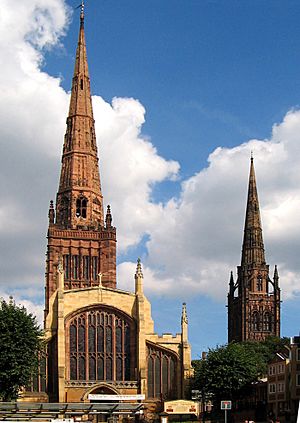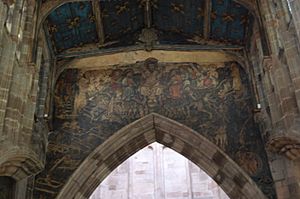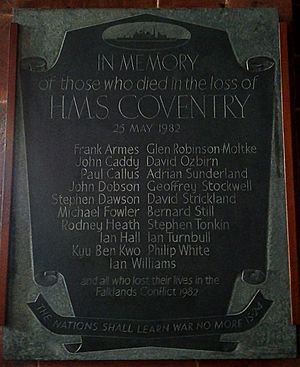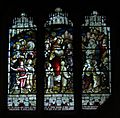Holy Trinity Church, Coventry facts for kids
Quick facts for kids Holy Trinity Church, Coventry |
|
|---|---|

Holy Trinity Church (left); the spire of the old St Michael's Cathedral is to the right
|
|
| 52°24′31″N 01°30′32″W / 52.40861°N 1.50889°W | |
| Denomination | Church of England |
| Previous denomination | Roman Catholic |
| Churchmanship | Broad Church |
| Website | www.holytrinitycoventry.org.uk |
| History | |
| Dedication | Holy Trinity |
| Administration | |
| Parish | Coventry |
| Diocese | Coventry |
| Province | Canterbury |
Holy Trinity Church, Coventry, is a historic church in Coventry, England. It belongs to the Church of England. Inside, above the main arch, there is a very old and impressive wall painting called a "doom painting."
Contents
A Look at the Church's History
This church was first built way back in the 12th century. It is the only medieval church in Coventry that is still standing completely. The church is about 59 meters (194 feet) long. Its tall spire reaches 72 meters (236 feet) high. This makes it one of the tallest church spires in the UK, not counting cathedrals.
The church has been repaired and updated many times over the years.
- From 1665 to 1668, the church was restored.
- In 1826, the tower was rebuilt by Thomas Rickman.
- The east end was rebuilt in 1786.
- The west front was rebuilt by Richard Charles Hussey in 1843.
- Inside, the church was restored by George Gilbert Scott in 1854.
The Amazing Doom Painting
The special "doom wall-painting" was created in the 1430s. It is located above the tower arch. This painting shows scenes of the Last Judgment.
It was hidden for a long time. In 1831, people discovered it under a layer of white paint. An artist named David Gee restored it and added varnish. However, the varnish turned dark over time, hiding the painting again.
In 1995, work began to clean and restore the painting once more. It was finally fully revealed in 2004, looking bright and clear again.
The Church Organ
Holy Trinity Church once had a very old and complex pipe organ. Many different builders worked on it over hundreds of years. The last major work was done by Henry Willis & Sons.
Organ Timeline
- 1526: The first organ was built by John Howe and John Clynmowe for £30. Later in the 1500s, it was taken apart because some church leaders, called Puritans, did not like organs.
- 1631: A new organ was brought in by the Vicar, Samuel Buggs.
- 1640s: The Puritans were in charge again. This organ was sold for £30.
- 1732: A German builder, Thomas Swarbrick, built a new organ for £600. It had two keyboards and was placed on a special balcony.
- 1829: More parts were added to the organ, including a "Swell" and "Pedal" section.
- 1855–1861: As part of the church's big restoration, a new room was built for the organ. A new instrument with three keyboards and pedals was built by Forster and Andrews for £800.
- 1900: The organ was rebuilt by W. Hill & Sons. Some older parts were used again. It now had four keyboards.
- 1923: An electric system was added to blow air into the pipes.
- 1933: J. Charles Lee added pneumatic pistons, which are like special buttons for the organist.
- 1961: The organ was rebuilt again by Henry Willis for £12,200. It had 59 "speaking stops" (different sounds), each with 61 pipes.
- 2007: Sadly, the organ was too old and broken to be fixed. It was taken apart. A fundraising effort started to get a new organ, which was expected to cost around £600,000.
Organists of Holy Trinity Church
Many talented musicians have played the organ at Holy Trinity Church over the centuries. Here are some of them:
- William Lambe (1631–1640)
- Mr. Harrison (1684–1696)
- Mr. Spencer (1696–1731)
- John Barker (1731–1752)
- Capel Bond (1752–1790)
- John Owen (1790–1797)
- Matthew Payne (1797–1818)
- Jane Lowe (1818–1856)
- Edward Simms (1821–1822)
- Frank Frederick Cuisset (1856–1860)
- H.J. Bailey (1860–1862)
- Arthur Anwill Evans (1862–1866)
- William Chater (1866–1880)
- A. Hanson (1880–1899)
- Charles Harry Moody (1899–1902)
- Percy E. Hughes (1902 – around 1907)
- Christie Green (1912 – 1918)
- Harold Bartrum Osmond (1918 – around 1931)
- Leonard Tanner (around 1950–1960)
- Martyn Lane (1965–1975)
- Peter Johnson (1975–1979)
- Andrew Moodie (around 1981)
- Jeremy Filsell (around 1981)
- Christopher Howard (1981–1990, and 1992–2013)
- Indra Hughes (1990–1992)
- David Baxter (1982–1991)
- Alexander Norman (2013–present)
Assistant Organists
- Sullivan D.T. Mortimer (around 1900)
- Norman Coke-Jephcott (1909–1911)
- Harold Carpenter (around 1950–60)
- Peter Bourton (around 1954–64)
Important Church Leaders
Many important clergy members have served at Holy Trinity Church. These are people who work for the church, like vicars and curates.
List of Vicars
The Vicar is the main priest in charge of the church. Here is a list of some of the Vicars who have led Holy Trinity Church, with the year they started:
- Ralph de Sove (no dates known)
- Henry de Harenhale (1298)
- John de Holland (1334)
- John Greneburgh (1346)
- Egidius Fillilod (1349)
- William Swet (1380)
- John de Amcotes (1381)
- John Brideston (no dates known)
- William Gamell (1383)
- Nicholas Crosloy (1421)
- John Meneley (1443)
- Thomas Bowde (no dates known)
- Thomas Orton (1508)
- Richard Collett (no dates known)
- Nicholas Darington (1527)
- Roger Capp (no dates known)
- William Benet (1546)
- George Brooche (1554)
- George Cheston (1568)
- Anthony Fletcher (1576)
- Humphrey Fenne (1577)
- Richard Eaton (1590)
- Thomas Cooper (1604)
- Samuel Gibson (1610)
- John Staresmore (1618)
- Samuel Buggs (1626)
- Henry Carpenter (1633)
- Joseph Brown (1636)
- Robert Proctor (1638)
- John Bryan (1644)
- Nathaniel Wanley (1662)
- Samuel Barton (1680)
- Jonathan Kimberley (1681)
- Samuel Kimberley (1712)
- John Macklin (1734)
- Nathaniel Gerard (1752)
- Joseph Rann (1773)
- John Davies (1811)
- Walter Farquhar Hook (1828–1837)
- John Howells (1837)
- William Drake (1857)
- Alfred William Wilson (1864)
- Francis M. Beaumont (1872–1912)
- R. Basil Littlewood (1912)
- Acland F. O'N. Williams (1929)
- Graham W. Clitheroe (1931)
- Lawrence Jackson (1965–1973)
- Nigel Douglas Blayney Abbott (1973–1980)
- Graham Dow (1981–1992)
- David Andrew Urquhart (1992–2000)
- Gordon Keith Sinclair (2001–2007)
- David Mayhew (2009–2016)
- Graeme Anderson (2017-2021)
- Richard Hibbert (from 2022)
Beautiful Stained Glass Windows
The church has many beautiful stained glass windows. These windows tell stories and show important figures from the Bible and church history.
-
The Brides' Window. This East window was made by Ninian Comper in 1956.
See also
- Grade I listed buildings in Coventry
- The Lutterworth Doom Painting









